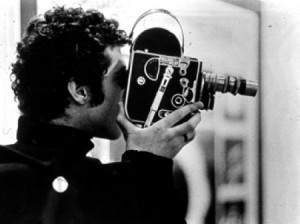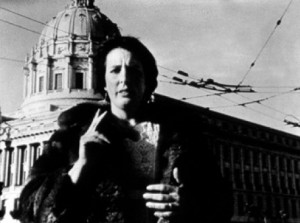Seven Screenings at the Art Gallery of Ontario, Jackman Hall, 317 Dundas Street West, McCaul Street Entrance
Thursday, November 15 – 6:30pm and 8pm
Friday, November 16 – 6:30pm and 8pm
Saturday, November 17 – 3pm, 6:30 and 8pm
Curator Jon Gartenberg in person!
Screenings $5 each. Free for current Ryerson, University of Toronto and York University students (with ID).
Sponsored by the AGO; Cinema Studies Institute, University of Toronto; Department of Film, Faculty of Fine Arts, York University; and School of Image Arts, Ryerson University.
Suffused with a love of image, melodrama and the teachings of Sirk and Hitchcock, the films of Warren Sonbert (1947-1995) are wonderful records of his vibrant surroundings in New York and San Francisco and his travels abroad. Gorgeously shot and meticulously edited, his films serve as an important touchstone for the possibilities of personal filmmaking. Early Monthly Segments is pleased to be able to host a retrospective of his films organized by Jon Gartenberg and imported from Light Cone in Paris. A rare chance to see the complete body of work of a stunning filmmaker.
“In [Sonbert’s] best work, behind the mask of unalloyed visual pleasure lurks a dramatic intensity and trajectory, not just of personal concerns or protracted journeys but of massive social upheavals, the melding or collision of distinct cultural rituals of crisis, cessation, renewal.” – Paul Arthur
The prints were preserved by the Estate Project for Artists with AIDS at the Academy of Motion Picture Arts and Sciences in Los Angeles, California
Special thanks to our IndieGoGo campaign supporters: Erika Balsom, Christina Battle, Stephen Broomer, Dan Browne, Rob Butterworth, Jon Davies, Elena Duque, Max Gatta, Chris Gehman, Susan Harris, Salah Hassanpour, Eli Horwatt, Derek Jenkins, Mark Loeser & Christine Lucy Latimer, Andrew J. Paterson, John Price, Lina Rodriguez, Marty Spellerberg, Leslie Supnet & Clint Enns, Bart Testa, Carly Whitefield, Blake Williams, and Michael Zryd.
Screening Schedule
(program notes by Jon Gartenberg)
Download extensive PDF version here.
Queer Identity
Thursday, November 15 – 6:30pm
Of the many creative and cultural universes inhabited by Sonbert, none was perhaps more acutely experienced yet least publicly acknowledged than his homosexual identity and affliction with AIDS. This program examines Sonbert’s relationship to the gay universe, beginning with his provocative and playful first film, Amphetamine, which depicts young men shooting amphetamines and making love in the era of sex, drugs, and rock and roll. The program continues with Noblesse Oblige, a masterfully edited work that features imagery Sonbert photographed of protests in San Francisco following the murders of Mayor George Moscone and Councilman Harvey Milk at the hands of Dan White. (Sonbert modeled the structure of this film on Douglas Sirk’s Tarnished Angels). The program culminates with Whiplash, his elegiac meditation on his own mortality, a film that was completed posthumously according to Sonbert’s instructions.
Films: Amphetamine, made with Wendy Appel, 1966, B/W, sound, 10 min.
Noblesse Oblige, 1981, color, silent, 25 min.
Whiplash, Completed posthumously in 1997. Restoration editor: Jeff Scher, 1995, color, sound, 20 min.
From Mise-en-Scene to Montage
Thursday, November 15 – 8pm
One of the most profound themes coursing throughout Sonbert’s work is that of love between couples in all its pitfalls and perfect moments. Sonbert expressed this theme not only between his protagonists onscreen, but also in the relationship between his ever-roving hand-held camera and the human subjects within his field of vision. The Bad and the Beautiful is noteworthy for Sonbert’s use of in-camera editing, in which he assembled together individual 100’ camera rolls (that he shot) into a series of mini-narratives. Each camera roll sequence captures an individual couple in unusually intimate, quotidian moments: eating, making love, dancing, and whiling away the time. Beginning in 1968, Sonbert abandoned his earlier filmmaking style, which had brought him such notoriety in the public press while he was still a teenager. He began using his hand-held Bolex camera to enlarge his field of vision beyond New York, recording footage as he traveled around the world. The Tuxedo Theatre offers evidence of Sonbert’s first steps in developing his unique style of montage, which subsequently resulted in his magnum opus, Carriage Trade.
Films: The Bad and the Beautiful, 1967, color, sound, 34 min.
Tuxedo Theatre, 1968, color, silent, 21 min.
Overarching Themes: Art & Industry, Militarism & Feminism (The Female Gaze)
Friday, November 16, 6:30pm
Sonbert’s montage works were meticulously constructed in the selection and sequencing of individual shots. Film theorist Noel Carroll gave the term “polyvalent montage” to Sonbert’s working style, in which each shot “can be combined with surrounding shots along potentially many dimensions.” Sonbert himself once wrote, that “the ambition might be seen as an attempt to hold finely balanced series of tensions in which one can read images a variety of ways, sometimes in contradictory stances so that there are many possibilities of interaction. “Each of Sonbert’s films after Carriage Trade was structured with an overarching theme in mind. Divided Loyalties, according to Sonbert, is about “art vs. industry and their various crossovers.” Honor and Obey questions all forms of male-dominated authority, particularly familial, religious, political, and military. Sonbert modeled A Woman’s Touch after Hitchcock’s Marnie, both in the stylistic interplay between “images of [en]closure and escape,” and in the thematic tension between male domination and female independence.
Films: Divided Loyalties, 1978, color, silent, 22 min.
Honor and Obey, 1988, color, silent, 21 min.
A Woman’s Touch, 1983, color, silent, 22 min.
The Travel Diary
Friday, November 16, 8pm
In Carriage Trade, Sonbert interweaves footage taken from his journeys throughout Europe, Africa, Asian and the United States, together with shots he removed from the camera originals of a number of his earlier films. Carriage Trade was an evolving work-in-progress, and this 61-minute version is the definitive form in which Sonbert realized it, preserved intact from the camera original. With Carriage Trade, Sonbert began to challenge the theories espoused by the great Soviet filmmakers of the 1920’s; he particularly disliked the “knee-jerk’ reaction produced by Eisenstein’s montage. In both lectures and writings about his own style of editing, Sonbert described Carriage Trade as “a jig-saw puzzle of postcards to produce varied displaced effects.” This approach, according to Sonbert, ultimately affords the viewer multi-faceted readings of the connections between individual shots. This occurs through the spectator’s assimilation of “the changing relations of the movement of objects, the gestures of figures, familiar worldwide icons, rituals and reactions, rhythm, spacing and density of images.”
Film: Carriage Trade, 1972, color, silent, 61 min.
60’s New York
Saturday, November 17, 3pm
Sonbert began making films in 1966, as a student at New York University’s film school. His earliest films, in which he captured the spirit of his generation, were inspired first by the university milieu and then by the denizens of the Warhol art world. Sonbert described the scenes from Where Did Our Love Go?, as follows: “Warhol Factory days…serendipity visits, Janis and Castelli and Bellevue glances…Malanga at work…glances at Le Mépris and North by Northwest…Girl rock groups and a disco opening…a romp through the Modern.” Hall of Mirrors is an outgrowth of one of Sonbert’s film classes at NYU, in which he was given the outtakes from a Hollywood film (starring Fredric March and Florence Eldridge) to re-edit into a narrative sequence. Adding to this found footage, Sonbert filmed Warhol’s superstar René Ricard in more private and reflective moments, and Gerard Malanga in public view at an art gallery. The film has a sophisticated circular structure, beginning and ending with the protagonists’ movements enmeshed within multiple reflecting mirrors. The Tenth Legion stylistically exemplifies Sonbert’s masterful use of a constantly moving hand-held camera as it trails the college-age protagonists in choreographed fashion, and of chiaroscuro lighting effects in interior scenes. Critic Greg Barrios wrote about this film: “People [are] engaged in their living, in their purpose, in their contribution, however trivial or important, to the work of the world.” Sonbert’s attention to capturing on film the minutiae of daily existence can be seen as a precursor to his mature montage films made years later, in which he melded diverse human gestures into a unified global vision.
Films: Where Did Our Love Go?, 1966, color, sound, 15 min.
Hall of Mirrors, 1966, color, sound, 7 min.
The Tenth Legion, 1968, color, sound, 30 min.
Silent Rhythms/Sound Symphonies 1
Saturday, November 17, 6:30
Rude Awakening, according to Sonbert, is “about Western civilization and its work; activity ethic and the viability of performing functions and activities.” Sonbert’s vivid color palette enhances the ritualistic nature of each action observed. Set against this lush panorama, Sonbert subverts the expectation of classic cinematography with a liberal sprinkling of avant-garde techniques. The incorporation of the materiality of film, the treatment of light, and the use of a hand-held camera, all suggest the influence of Stan Brakhage, Sonbert’s “hero”. Sonbert was also a professional music critic. In Friendly Witness, he returned, after 20 years of making films, to incorporating music tracks back into his movies. In doing so, he select




